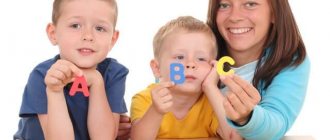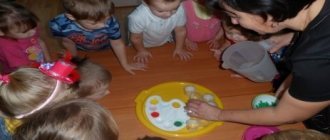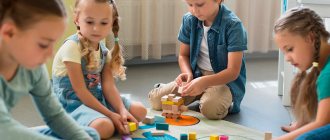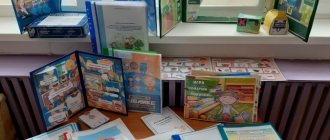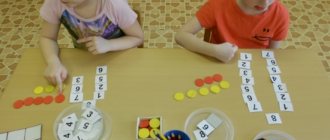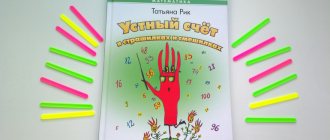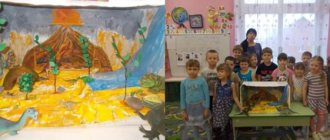Speech development in kindergarten. Program and methodological recommendations. For working with children 2-7 years old
In the context of solving the problems of mental education and the overall development of the child, serious attention is paid to the work of teaching oral speech.
For each age group, the approximate level of speech development, the sequence of work on mastering the sound system of the language, its vocabulary, grammatical structure, dialogic and monologue speech are determined; In older groups, the content of preparing children for mastering literacy has been developed.
In classes on the development of speech and outside of them, in the process of becoming familiar with the surrounding world, nature, as well as while reading works of fiction, the teacher leads children to understand that words denote objects and phenomena of this world and have a certain meaning, which for precise expression thoughts, you need to select the words that are most appropriate in meaning.
Preparing children to master oral speech begins with the first group of early age[1]. In the program of this group, the main objectives are: the development of humming and babbling, which contribute to the development of the articulatory apparatus, auditory concentration, vocal reactions, the accumulation of a passive vocabulary and the formation of the ability to repeat some simple words after the teacher.
The program of the second group of early age, when the child’s speech becomes a means of communication with adults and peers, provides for the formation of correct sound pronunciation and the initial forms of coherent speech.
In the first and second junior groups, teachers create conditions for enriching and activating the vocabulary, and for children to use simple sentences in oral speech.
The middle group program is aimed at children mastering the correct pronunciation of all sounds of their native speech, developing skills in retelling and composing short stories.
In the older group, a special place is occupied by the improvement of phonemic hearing and the further development of coherent speech.
In the school preparatory group, work is actively carried out to prepare children to master the basics of literacy. The teacher leads children to the sound analysis of words, teaches them to divide words into syllables, to compose words from syllables, and from words into sentences, and gives the first ideas about a word or a sentence (without grammatically defining them).
In all age groups, exercises are conducted to develop dialogic speech and create a culture of verbal communication. The teacher develops the child’s independent active speech, encourages the desire to speak and communicate with other people.
The improved version of the program includes a new section “Developing Speech Environment”. Its main goal is to determine the characteristics of the organization of the developing speech environment in all kindergarten groups, as well as to promote the improvement of the child’s speech communications in kindergarten with adults, peers and younger and older children.
In national preschool educational institutions, where work is carried out in their native language, children from the first group of early age are taught oral native speech according to a program developed in the republic, territory, region, and from the middle and senior groups - Russian colloquial speech.
In those preschool educational institutions where work with children of non-Russian nationality is carried out in Russian, from the senior group, teaching the native language is introduced according to educational programs developed in the regions.
GAMES ON THE SOUND CULTURE OF SPEECH Game “Replace the sound” Purpose: To teach children to mentally rearrange, replace sounds with given ones, and name the resulting new words. Material: Rows of words for transformation, object pictures with words that should be obtained. Progress of the game: The adult sets the sound with which the first or last sound in the word will need to be replaced. Then he lays out the pictures and pronounces the words, and with their help the child mentally replaces the sound in the original word with the given one and says the resulting word out loud. For example, you need to replace the first (porridge - cup, nut - seagull, suit - part) or the last sound (enemy - doctor, beak - key, chalk - sword) with [h]. As you practice, the game can be played by ear, without using pictures “What sound is missing?” Goal: To improve children's sound analysis skills. Material: Subject pictures for each word. Progress of the game: An adult selects pictures with words, lays them out on the table and names them, replacing the desired sound with a pause. The child must guess what the word is using the corresponding picture and identify the missing sound in it. For example, pi[ ]ama - the sound [zh] is gone, vocal[ ]al -sound [z], tarel[ ]a - sound [k], conf[ ]a - sound [t], mar-ty[ ]ka - [w], maka[ ]ons - [r], etc. An adult can select pictures with words for a specific sound, the pronunciation of which needs to be reinforced in the child. “Change the word” Purpose: To practice the formation of nouns with a diminutive meaning. Practice diction. Progress of the game: Children must change the words so that the sound [zh] appears in them: friend - friend, pie - pie, boot - boot, snow - snowball, horn - horn, meadow - meadow, cottage cheese - cottage cheese, flag - flag. “The third wheel” Goal: To develop the ability to hear a certain sound in a word. Progress of the game: From three pictures, children must remove the one whose name does not have the sound [w]: tire, lily of the valley, squirrel; hat, accordion, saw; dove, fur coat, tumbler; mice, banana, gun. “Name the picture and find the first sound” Purpose: To teach children to find the given first sound in a word at the stage of loud pronunciation of the word by the child himself. Material: Cards with drawn pictures. Progress of the game: Children have cards with drawn pictures. The teacher names any vowel sound, the children say the names of their pictures out loud and find the one they need. If the picture is named correctly, the presenter allows you to cover it with a chip. The one who closes their pictures first wins. “Trap” Goal: To develop the ability to hear a certain sound in a word. Progress of the game: The teacher invites the children to “open the traps”, i.e. place your elbows on the table, parallel to each other, straightening your palms, which are the “traps”. Educator: If you hear a given sound in a word, then the “traps” need to be slammed, i.e. clap your hands. Words are selected by the teacher depending on the topic of the lesson. “Chain of words” Purpose: To expand the stock of nouns in the active vocabulary of children. Material: Ball, badges, etc. How to play: In this game you need to create a chain of words so that the last sound of the previous word coincides with the first sound of the next one. The players sit in a circle. One of them throws a ball to someone and says a word (noun), such as “glass.” The person receiving the ball says a word that begins with the last sound of the spoken word, for example, “leg.” The next one says, for example, “April”, followed by “leaf”, etc. The one who does not completely leave the game wins. The winner is awarded a badge. “Which sound is heard most often?” Purpose: To train children in identifying the sound that sounds more often; develop mental operations, phonemic hearing. Progress of the game: The presenter gives the children the task: “I will read a poem, you listen carefully and determine which sound is heard most often.” I don’t buzz when I sit, I don’t buzz when I walk, I don’t buzz when I work, I buzz when I spin. The mosquito buzzed subtly: Z-z-z - he sings loudly, loudly, Repeats his story many times to the frisky midges. VOCABULARY DEVELOPMENT GAMES “Catch and throw - name the colors” Purpose: To practice selecting nouns for the adjective denoting color. Material: Ball. Progress of the game: What color we have - we will tell you about it. An adult, throwing a ball to a child, names an adjective denoting color, and the child, returning the ball, names a noun that matches this adjective. Adult: red – Child: poppy, fire, orange flag – orange, carrot, dawn; yellow - chicken, sun, turnip; green - cucumber, grass, forest; blue - sky, ice, forget-me-nots; blue - bell, sea, ink; purple - plum, lilac, twilight. “What object is this?” Purpose: To consolidate the agreement of an adjective with a noun. Material: Ball. How to play: An adult names the sign and throws the ball to one of the children. The child who catches the ball names the object that has this sign and returns the ball to the speech therapist. Next, the adult throws the ball to other children in turn. For example: Long - rope, fur coat, thread, street, elastic, braid, skirt, road, elastic, ribbon, shirt, curtain. Long - train, lace, cucumber, day, pencil, knife, jacket. Wide - street, river, ribbon, road, jacket, skirt, elastic band. Wide - scarf, alley, courtyard, corridor, window sill. Red - star, berry, ribbon, hat, shirt, T-shirt, raspberry. Red - ball, scarf, tomato, poppy, house, pencil. Round - ball, globe, petal, tomato. Round - sun, egg, apple, wheel. “Pick up a word” Goal: Expand children’s vocabulary, develop the ability to coordinate an adjective with a noun. How to play: This game can be played with a ball, throwing it to each other. What can you say about: “Fresh”... (air, cucumber, bread, wind); “old”... (house, stump, person, shoe); “fresh”... (bun, news, newspaper, tablecloth); “old”...(furniture, fairy tale, book, grandmother); “fresh”... (milk, meat, jam); “old”...(chair, seat, window). “Guess the object” Goal: Develop thinking, activate vocabulary. How to play: Guess the item by the name of its parts. Body, cabin, wheels, steering wheel, headlights, doors (truck). Trunk, branches, twigs, leaves, bark, roots (tree). Bottom, lid, walls, handles (pan). Deck, cabin, anchor, stern, bow (ship). Entrance, floor, stairs, apartments, attic (house). Wings, cockpit, tail, engine (airplane). Eyes, forehead, nose, mouth, eyebrows, cheeks (face). Sleeves, collar, cuffs (shirt). Head, torso, legs, tail, udder (cow). Floor, walls, ceiling (room). Window sill, frame, glass (window). “Family” Purpose: To teach children to understand family relationships, to use words denoting kinship and relatives. Material: Ball. Progress of the game: Who are you to me and who am I to you if you are my family? An adult, throwing a ball to a child, asks a question, which the child must answer when returning the ball. Sample questions: • How are you related to mom and dad? • Who are you to your grandparents? • Do you have a sister or brother? • Name your cousins. • Who are your cousins' parents to you? This concludes our review of games. Once again we would like to draw the attention of parents to the fact that games for developing a child’s vocabulary are varied and the content depends only on your imagination and desire to work. “What grows in the forest?” Goal: To activate children’s vocabulary of nouns on the topics: “Plants”, “Animals” Material: Chairs according to the number of children. Progress of the game: The teacher selects three children and invites them to name what grows in the forest. For example, one says: “A mushroom grows in the forest,” the second says “raspberries,” the third says “spruce,” and then the first one continues again. The teacher warns that you cannot think for long. When the players break the rules, they sit down and choose a replacement. A new group of children is given a different task, for example, to list what grows in the garden or who lives in the forest. The winner is the one who names the most plants and animals. He receives a prize. “Whose home is this?” Purpose: To consolidate children’s knowledge about animal homes. Material: Pictures of animals and pictures depicting animal homes. Progress of the game: There are pictures on the board. On the left are pictures depicting animal homes, on the right are images of animals (not near their homes). The teacher explains that Dunno mixed up the animal houses. We need to help them find theirs. Children rearrange the images of animals, placing them near their homes, and then name whose homes they are: a hole - for a fox, a mouse; den - for a bear; hollow - for a squirrel, for an owl; nest - for a bird; birdhouse - for the starling; barn - for cows, calves; stable - for horses, foals; pigsty - for pigs and piglets; rabbitry - for rabbits. Before completing this task, children fix the names of the dwellings of domestic and wild animals and birds from the pictures. “Months and their sequence” Purpose: To consolidate temporary concepts in the child’s active vocabulary. Material: Ball. Progress of the game: Month after month rises - everyone will name them all. An adult with children names the months by throwing a ball on the floor: “January, February, March...”. Instead of the next month, the adult calls the child’s name: “Masha!” The child picks up the ball and continues to name the months, slamming the ball on the floor. “Catch, throw, name the days of the week” Goal: To consolidate temporary concepts in the child’s active vocabulary. Material: Ball. Progress of the game: It was not in vain that we looked at the calendar - we all remember the days of the week. The players stand in a circle. The presenter, throwing the ball to someone, can start on any day of the week: “I’ll start, you continue, name the days of the week!” Wednesday…” Everyone takes turns throwing the ball to each other and sequentially calling out the days of the week. Complication. The child and parents stand in a circle and, naming the days of the week, slam the ball on the floor for each word: “Monday. Tuesday..." Instead of the next day of the week, the adult calls the child's name: "Sasha!" The child picks up the ball and continues, throwing the ball on the floor. You can call the days of the week in reverse order. "What why?" Goal: To consolidate temporary concepts in the child’s active vocabulary. Develop thinking. Material: Ball. Progress of the game: What do we look for every year and all year round? The players stand in a circle. The presenter throws the ball to the players one by one and asks questions. For example: “Winter. And what’s behind it?” The player answers: “Spring,” and throws the ball to the leader. Question options: “Winter. And what’s behind it?” - "Spring. “What’s behind it?” “How many months are there in a year?” “Name the summer months.” “Name the first month of spring.” “Name the last month of winter.” “What month does autumn begin from?” “What month does autumn end in?” “It happens - it doesn’t happen” Goal: Expand and consolidate children’s active vocabulary. Develop logical thinking. Material: Ball. Progress of the game: What will happen, what won’t? Give me an answer quickly! The players stand in a circle. The presenter calls the seasons. For example: "Summer". And then, throwing the ball to someone, he names a natural phenomenon. For example: “Ice drift”. The child who caught the ball must say whether this happens or not. The game goes in circles. Whoever makes a mistake leaves the game. Variants of natural phenomena and seasonal changes: frost, ice drift, drops, leaf fall, blizzard, frost, rain, snow, hail, thunderstorm, etc. Complication. The child gives complete answers, explaining the possibility or impossibility of this or that natural phenomenon at a given time of year. “Say the opposite” Goal: Expand the vocabulary of antonyms in children. Material: Ball. How to play: Throw the ball to the child and say the word. The child, returning the ball, names a word with the opposite meaning. Now you and I will turn into stubborn people who do everything the opposite. I throw you a ball and say a word, and you say the opposite. For example: dark, but vice versa - light. Friend...enemy Day...night Joy...sadness (sadness) Ceiling...floor Heat...cold Evil...good Truth...lie Fast...slowly Speak...silent Buy...sell Raise...lower Throw...raise (catch) Hide...look Light...extinguish Dress... undress Lose...find Put...remove Give...take Pour...pour out Good...bad Hard...easy High...low Far...close Possible...impossible Difficult...easy Beginning...end. GAMES FOR FORMING THE GRAMMAR STRUCTURE OF SPEECH “Say kindly” Goal: To consolidate the ability to form nouns using diminutive and affectionate suffixes. Develop agility and reaction speed. Material: Ball. Progress of the game: An adult, throwing a ball to a child, calls the first word (for example, ball), and the child, returning the ball, calls the second word (ball). Words can be grouped according to similar endings. Table - table, key - key. Hat - cap, squirrel - squirrel. A book is a little book, a spoon is a spoon. The head is the head, the picture is the picture. Soap - soap, mirror - mirror. A doll is a doll, a beet is a beet. Braid - braid, water - water. Beetle - beetle, oak - oak. Cherry - cherry, tower - turret. A dress is a dress, an armchair is an armchair. A feather is a feather, glass is a piece of glass. A watch is a watch, panties are panties. "Who is this?" Goal: To activate children's vocabulary on the topic “Sports”. Form the sound-syllable structure of a word. Develop grammatical structure of speech. Progress of the game: Plays sports (who?) - athlete, female athlete practices gymnastics - gymnast, female gymnast practices figure skating - figure skater, female figure skater practices tennis - tennis player, female tennis player practices wrestling - wrestler practices acrobatics - acrobat, female acrobat skis - skier, female skier runs on skates - a speed skater, a female skater plays football - a football player, a soccer player plays hockey - a hockey player, a female hockey player plays chess - a chess player, a female chess player shoots from a rifle - an archer shoots from a bow - an archer, an archer rides a bicycle - a cyclist, a female cyclist rides a motorcycle - a motorcyclist, a motorcyclist high jumps, a long jumper - a jumper, a female jumper jumps with a parachute - a parachutist, a parachutist swims - a swimmer, a female swimmer. “Name the professions” Goal: Develop analysis and synthesis. Material: Pictures depicting different professions. Progress of the game: An adult invites children to answer the questions: Who carries the luggage? Porter. Who welds the pipes? Welder. Who installs the glass? Glazier. Who works on the crane? Crane operator. Who lays the stones? Mason. Who sharpens knives? Grinder. Who repairs the clock? Watchmaker. Who works on an excavator? Excavator operator. Next, the adult asks the question: - What is the common part in the words porter, welder, glazier, crane operator, mason, grinder, watchmaker, excavator operator? When pronouncing these words, the adult emphasizes the suffix -schik- in intonation and voice.
